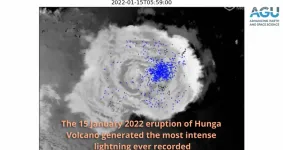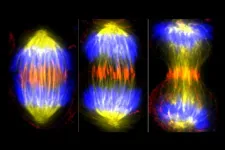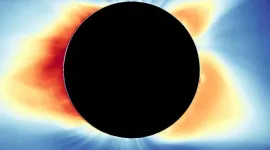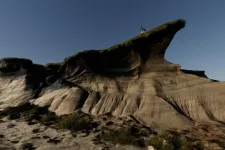(Press-News.org) American Geophysical Union
Release No. 23-26
20 June 2023
For Immediate Release
This press release and accompanying multimedia are available here: https://news.agu.org/press-release/tongas-hunga-eruption-produced-the-most-intense-lightning-ever-recorded/
Additional study highlights:
The 15 January eruption lasted at least 11 hours, several hours longer than previously known
The plume produced the highest-altitude lightning flashes ever measured, 20 to 30 kilometers (12 to 19 miles) above sea level
Lightning “surfed” giant waves that rippled through volcanic plume
Lightning data reveal previously unknown phases of the eruption, inform future volcanic hazard monitoring
AGU press contact:
Rebecca Dzombak, news@agu.org, +1 (202) 777-7492 (UTC-4 hours)
USGS press contact:
Paul Laustsen, USGS Public Affairs, plaustsen@usgs.gov (UTC-7 hours)
Contact information for the researchers:
Alexa Van Eaton, USGS – Cascades Volcano Observatory, avaneaton@usgs.gov (UTC-7 hours)
Dr. Van Eaton should be contacted directly for interview requests.
WASHINGTON — The January 15, 2022, eruption of Hunga Volcano in Tonga continues to break records. According to a new study, the eruption created a “supercharged” thunderstorm that produced the most intense lightning ever recorded. There were nearly 200,000 lightning flashes in the volcanic plume throughout the eruption, peaking at more than 2,600 flashes every minute, the researchers found.
When the submarine volcano erupted in the southern Pacific Ocean, it generated a plume of ash, water and magmatic gas at least 58 kilometers (36 miles) high. The towering plume gave scientists useful information about the scale of the eruption, but it also obscured the vent from satellite view, making it more difficult to track changes in the eruption as it progressed.
High-resolution lightning data from four separate sources — never previously used all together — have now let scientists peer into that plume, teasing out new phases of the eruption’s life cycle and gaining insights into the weird weather it created.
“This eruption triggered a supercharged thunderstorm, the likes of which we’ve never seen,” said Alexa Van Eaton, a volcanologist at the United States Geological Survey who led the study. “These findings demonstrate a new tool we have to monitor volcanoes at the speed of light and help the USGS’s role to inform ash hazard advisories to aircraft.”
The study was published in Geophysical Research Letters, which publishes high-impact, short-format reports with immediate implications spanning all Earth and space sciences.
The storm developed because the highly energetic expulsion of magma happened to blast through the shallow ocean, Van Eaton said. Molten rock vaporized the seawater, which rose up into the plume and eventually formed electrifying collisions between volcanic ash, supercooled water and hailstones. The perfect storm for lightning.
Combining data from sensors that measure light and radio waves, the scientists tracked lightning flashes and estimated their heights. The eruption produced just over 192,000 flashes (made up of nearly 500,000 electrical pulses), peaking at 2,615 flashes per minute. Some of this lightning reached unprecedented altitudes in Earth’s atmosphere, between 20 to 30 kilometers (12 to 19 miles) high.
“With this eruption, we discovered that volcanic plumes can create the conditions for lightning far beyond the realm of meteorological thunderstorms we’ve previously observed,” Van Eaton said. “It turns out, volcanic eruptions can create more extreme lightning than any other kind of storm on Earth.”
The lightning provided insight into not only the duration of the eruption, but also its behavior over time.
“The eruption lasted much longer than the hour or two initially observed,” Van Eaton said. “The January 15 activity created volcanic plumes for at least 11 hours. It was really only from looking at the lightning data that we were able to pull that out.”
The researchers saw four distinct phases of eruptive activity, defined by plume heights and lightning rates as they waxed and waned. The insights gained from linking lightning intensity to eruptive activity can provide better monitoring and nowcasting of aviation-related hazards during a large volcanic eruption, including ash cloud development and movement, Van Eaton said. It’s a significant challenge to get reliable information about volcanic plumes at the beginning of an eruption, especially for remote, submarine volcanoes. Harnessing all the long-range observations available, including lightning, improves early detection to keep aircraft and people out of harm’s way.
“It wasn’t just the lightning intensity that drew us in,” Van Eaton said. She and her colleagues were also puzzled by the concentric rings of lightning, centered on the volcano, that expanded and contracted over time. “The scale of these lightning rings blew our minds. We’ve never seen anything like that before, there’s nothing comparable in meteorological storms. Single lightning rings have been observed, but not multiples, and they’re tiny by comparison.”
Intense, high-altitude turbulence was again responsible. The plume injected so much mass into the upper atmosphere that it sent out ripples in the volcanic cloud, like dropping pebbles in a pond. The lightning appeared to ‘surf’ these waves and move outward as 250-kilometer-wide rings.
As if all that weren’t enough to make this eruption fascinating, it represents a style of volcanism known as phreatoplinian, which occurs when a large volume of magma erupts through water. Previously, this eruption style was only known from the geological record and had never been observed with modern instrumentation. The Hunga eruption changed all that.
“It was like unearthing a dinosaur and seeing it walk around on four legs,” Van Eaton said. “Sort of takes your breath away.”
#
AGU (www.agu.org) is a global community supporting more than half a million advocates and professionals in Earth and space sciences. Through broad and inclusive partnerships, AGU aims to advance discovery and solution science that accelerate knowledge and create solutions that are ethical, unbiased and respectful of communities and their values. Our programs include serving as a scholarly publisher, convening virtual and in-person events and providing career support. We live our values in everything we do, such as our net zero energy renovated building in Washington, D.C. and our Ethics and Equity Center, which fosters a diverse and inclusive geoscience community to ensure responsible conduct.
Notes for journalists:
This study is published in Geophysical Research Letters, a fully open-access journal from AGU. View and download a pdf of the study here.
The video accompanying this press release is online here. It may be reproduced with credit to AGU/Van Eaton et al. (2023), Geophysical Research Letters. It shows lightning flashes (blue dots, colored polygons) over GOES satellite imagery of the eruption on 15 January. This and an additional video are available in the supplement of the study online.
Paper title:
“Lightning rings and gravity waves: Insights into the giant eruption plume from Tonga’s Hunga Volcano on 15 January 2022”
Authors:
Alexa R. Van Eaton (corresponding author), U.S. Geological Survey, Cascades Volcano Observatory, Vancouver, WA, USA
Jeff Lapierre, Advanced Environmental Monitoring, Germantown, MD, USA
Sonja A. Behnke, Electromagnetic Sciences and Cognitive Space Applications, Los Alamos National Laboratory, Los Alamos, NM, USA
Chris Vagasky, Vaisala Inc., Louisville, CO, USA; currently at Department of Agronomy, University of Wisconsin Madison, WI, USA
Christopher J. Schultz, NASA Marshall Space Flight Center, Huntsville, AL, USA
Michael Pavolonis, NOAA/NESDIS Center for Satellite Applications and Research, Advanced Satellite Products Branch, Madison, WI, USA
Kristopher Bedka, NASA Langley Research Center, Hampton, VA, USA
Konstantin Khlopenkov, Science Systems and Applications, Inc., Hampton, Virginia, USA END
Tonga’s Hunga eruption produced the most intense lightning ever recorded
The eruption produced 2,600 flashes per minute at peak intensity. Scientists used the lightning to peer into the ash cloud, teasing out new details of the eruption’s timeline
2023-06-20
ELSE PRESS RELEASES FROM THIS DATE:
Rensselaer researcher to investigate the mechanics of mitosis to combat cancer
2023-06-20
It is a scary fact that one in two women and one in three men in the United States will develop some form of cancer in their lifetime. One of the hallmarks of many cancers is the occurrence of errors during the cell division process called mitosis. Therefore, critical to enhancing treatments or perhaps even finding a cure for cancer and other diseases, is developing a better understanding of how mitosis works in both healthy and diseased cells.
Rensselaer Polytechnic Institute’s Scott Forth, Ph.D., assistant professor of biological sciences ...
Mason College of Public Health researchers reveal how digital contact tracing applications can be utilized now that the pandemic is over
2023-06-20
During the pandemic, contact tracing apps kept Americans informed of potential exposure risk with the goal of reducing infections. But did apps like this help reduce the spread of COVID and how might we improve these apps for use in future outbreaks?
Contact tracing is a pivotal part of pandemic preparedness. Evidence-based research on best practices for contact tracing is important because when employed inefficiently contact tracing drains resources. Used effectively, contact tracing slows the spread of disease and saves lives. In the past, contact tracing was done through health ...
UNCG spin-off launches national study to help prevent opioid misuse
2023-06-20
Prevention Strategies received a grant from the National Institutes of Health to pursue the study and develop a commercially viable intervention tool based on prevention science. Known as WorkWell, it is a tailored mobile health app that represents the next generation of evidence-based, technology-aided intervention programs.
The initial pilot program to test the WorkWell app will focus on construction trade workers and nurses, as well as nursing assistants and technicians. These occupations have been disproportionately impacted by the opioid crisis and have high mortality ratios.
“Opioid-involved overdoses are among the leading causes of death in the United States despite extensive ...
UTHealth Houston study on repeated radiofrequency ablation in combination with chemotherapy for pancreatic cancer supported with $3.3M HHS grant
2023-06-20
A combination strategy of endoscopic ultrasound-guided radiofrequency ablation (EUS-RFA) with chemotherapy for pancreatic cancer will be studied at UTHealth Houston through a $3.3 million grant from the National Cancer Institute by the U.S. Department of Health and Human Services.
The survival rate of pancreatic adenocarcinoma, or pancreatic cancer, remains low, around 10%, because of its poor response to current chemotherapies.
The five-year grant will continue the established six-year clinical and translational research collaboration between Jennifer Bailey-Lundberg, ...
Breast cancer research team pulls in $3 million in national support
2023-06-20
UTHSC researchers working to find new treatments to combat breast cancer metastasis recently pulled in a major national award. Wei Li, PhD, distinguished professor of Pharmaceutical Sciences and director of the Drug Discovery Center in the College of Pharmacy, and Tiffany Seagroves, PhD, professor of Pathology in the College of Medicine, are principal investigators on a $3.07 million grant from the National Cancer Institute for a project to develop a new series of drugs targeting microtubules to stop the spread of breast cancer to the brain and bone. Duane Miller, PhD, professor emeritus, and Zhongzhi Wu, PhD, assistant professor, both in ...
Science in the shadows: NASA selects 5 experiments for 2024 total solar eclipse
2023-06-20
A total solar eclipse will darken a swath of North America as the Moon blocks the light of the Sun for a few minutes on April 8, 2024. In addition to casting a breathtaking, passing shadow over the heads of millions of people, this total solar eclipse gives scientists a unique opportunity to study the Sun, Earth, and their interactions.
NASA will fund five interdisciplinary science projects for the 2024 eclipse to make the most of this opportunity. The projects, which are led by researchers at different academic institutions, will study the Sun and its influence on Earth with a variety of instruments, including cameras aboard high-altitude research planes, ham radios, and ...
Dupilumab lessens disease in COPD patients with type 2 inflammation
2023-06-20
BIRMINGHAM, Ala. – Chronic obstructive pulmonary disease patients with type 2 inflammation saw rapid and sustained improvements in their disease after treatment with the monoclonal antibody dupilumab, according to a yearlong, Phase 3 clinical trial reported in the New England Journal of Medicine.
These improvements — as measured by a significantly lower annualized rate of acute exacerbations, significantly better lung function and quality of life, and significantly less severe symptoms than placebo-treated adults with COPD — were observed within two to four weeks after the initiation of dupilumab and were sustained throughout the 52-week trial period. This monoclonal antibody ...
Scientists discover new embryonic cell type that self-destructs to protect the developing embryo
2023-06-20
Scientists studying gene activity data of the early human embryo have discovered an overlooked type of cell which self-destructs within days of forming, as part of a quality control process to protect the developing foetus. The findings give insights on what happens at the very first stages of life after fertilisation which could in the future help improve IVF or regenerative medicine treatments.
A new study published on 20 June 2023 in PLoS Biology by an international team of scientists including researchers at the University of Bath, finds that our earliest development in the womb may be rather different to what we have always assumed.
While ...
National Geographic Explorers win award for visualizing arctic climate change
2023-06-20
FOR IMMEDIATE RELEASE: June 20, 2023 - Washington, D.C. - An innovative virtual reality project created by National Geographic Explorers in collaboration with local communities was recognized with the “Best in Category: Visualize” during the XR Prize Challenge: Fight Climate Change earlier this month. The project, “Qikiqtaruk: Arctic at Risk” was selected for the award from across 150 submissions at the Augmented World Expo (AWE) in Santa Clara, California on June 1, 2023.
“Qikiqtaruk: Arctic at Risk” brought together researchers, park rangers, educators and immersive content ...
NYU Abu Dhabi researchers develop first-of-its-kind adhesive bandage that can detect COVID-19 antibodies
2023-06-20
Abu Dhabi, UAE, June 20, 2023: Researchers at NYU Abu Dhabi have developed a new rapid testing method for COVID-19 – an adhesive bandage that relies on gold nanoparticles to quickly detect the immune antibodies in the bloodstream.
These antibodies, named IgM and IgG, are naturally produced as a result of SARS-CoV-2 infection, and therefore serve as valuable biomarkers to identify infected individuals and monitor the spread of pandemics. The innovative bandage technology is affordable and easy-to-use, and ...
LAST 30 PRESS RELEASES:
Scientists boost cell "powerhouses" to burn more calories
Automatic label checking: The missing step in making reliable medical AI
Low daily alcohol intake linked to 50% heightened mouth cancer risk in India
American Meteorological Society announces Rick Spinrad as 2026 President-Elect
Biomass-based carbon capture spotlighted in newly released global climate webinar recording
Illuminating invisible nano pollutants: advanced bioimaging tracks the full journey of emerging nanoscale contaminants in living systems
How does age affect recovery from spinal cord injury?
Novel AI tool offers prognosis for patients with head and neck cancer
Fathers’ microplastic exposure tied to their children’s metabolic problems
Research validates laboratory model for studying high-grade serous ovarian cancer
SIR 2026 delivers transformative breakthroughs in minimally invasive medicine to improve patient care
Stem Cell Reports most downloaded papers of 2025 highlight the breadth and impact of stem cell research
Oxford-led study estimates NHS spends around 3% of its primary and secondary care budget on the health impacts of heat and cold in England
A researcher’s long quest leads to a smart composite breakthrough
Urban wild bees act as “microbial sensors” of city health.
New study finds where you live affects recovery after a hip fracture
Forecasting the impact of fully automated vehicle adoption on US road traffic injuries
Alcohol-related hospitalizations from 2016 to 2022
Semaglutide and hospitalizations in patients with obesity and established cardiovascular disease
Researchers ‘listen in’ to embryo-mother interactions during implantation using a culture system replicating the womb lining
How changing your diet could help save the world
How to make AI truly scalable and reliable for real-time traffic assignment?
Beyond fragmented markets: A new framework for efficient and stable ride-pooling
Can shape priors make road perception more reliable for autonomous driving?
AI tracks nearly 100 years of aging research, revealing key trends and gaps
Innovative techniques enable Italy’s first imaging of individual trapped atoms
KIER successfully develops Korea-made “calibration thermoelectric module” for measuring thermoelectric device performance
Diversifying US Midwest farming for stability and resilience
Emphasizing immigrants’ deservingness shifts attitudes
Japanese eels, climate change, and river temperature
[Press-News.org] Tonga’s Hunga eruption produced the most intense lightning ever recordedThe eruption produced 2,600 flashes per minute at peak intensity. Scientists used the lightning to peer into the ash cloud, teasing out new details of the eruption’s timeline









